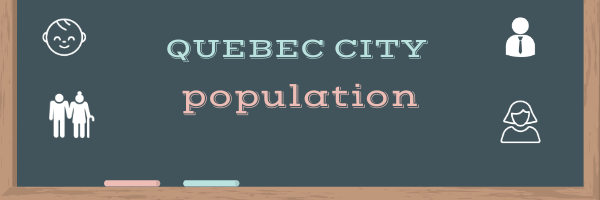
Quebec City is the capital city of Quebec province. Quebec City is Canada’s 8th populated city with an estimated population of over 720,000 people. It is an important port in the east, and the only city in North America with a wall. Located at the confluence of the St. Lawrence River and the St. Charles River. The city is divided into the upper and lower parts.
Based on our research, Quebec City population will reach 747,159 by end of 2025.The calculation is based on the average growth rate of 0.66% over last 13 years since 2011. We believe using the recent years’ figures (see the table in next section) will make the estimation more accurate. The estimation will adjust once Statistic Canada publishes census data.
Population Growth of Quebec City
Looking back last 13 years of Quebec City’s population, the growth rate is very slow but steady ranging from 0.60% to 0.69%, adding around 4,260 to 4,990 people each year to the overall population. Lot of people to choose to live in Quebec City because of its safe and friendly community, which contributes to the population growth. The population difference between census year 2011 and 2016 is 23,299, that means the population had increased by 3.4% over 5 years.
| Year | Population (Million) | Growth Rate |
| 2011 | 681,804 | n/a |
| 2012 | 686,463 | 0.66% |
| 2013 | 691,213 | 0.68% |
| 2014 | 695,892 | 0.65% |
| 2015 | 700,697 | 0.68% |
| 2016 | 705,103 | 0.63% |
| 2017 | 709,502 | 0.64% |
| 2018 | 714,282 | 0.67% |
| 2019 | 718,542 | 0.60% |
| 2020 | 723,140 | 0.64% |
| 2021 | 727,980 | 0.67% |
| 2022 | 732,970 | 0.69% |
| 2023 | 737,580 | 0.63% |
| 2024 | 742,290 | 0.64% |
Demographics of Quebec City
Quebec City is not a culture diverse city with many minority groups because 6.4% of Quebec City residents reported visible minority status, a relatively low figure for a large city; the national average was 22.3%. The major ones include: Black (2.4%), Latin American (1.3%), Arab (1.2%), Southeast Asian(0.5%), Chinese(0.4%), South Asian(0.3%) and West Asian(0.1%).
The religious makeup of Quebec City is: Christian (63.8%), No religion (20.14%), Muslim (7.6%), Jewish (10.6%), Buddhist (1.8%), Hindu (1.6%),Sikh (0.09%),Other(0.3%).
From age prospective, children under five accounted for around 4.7% of city population.20.6% of the population in Quebec City are 65 and over.65 is an average retirement age in Quebe City. The median age is 43.3 years of age which is relatively younger compared to 41.2 years of age for Canada as a whole.
In terms of languages, majority of city residents are native French speakers. According to Statistics Canada, 94.6% of Quebec City’s population spoke French as their first language, more than 30% of the residents an speak both French and English.
Population Density of Quebec City
Quebec City’s population density is 1,173 people per kilo square meter, which is quite normal for a major city in Canada.
Facts About Quebec City
- According to 2016 census, 48.2% of the populate were male and 51.8% were female.
- Quebec City is the only walled city north of Mexico. It has 4.6 kilometres of walls.
- The word “Kebec” is an Algonquin word meaning where the river narrows.
- The oldest part of Quebec City was declared a UNESCO World Heritage Site in 1985.
- Quebec City has 149 days on average per year when the snow is at least one inch deep.
- The average annual snowfall is 342 cms (135 inches) and the average annual rainfall is 86 cms (34 inches).
- The English-speaking community peaked in relative terms in the 1860s, when 40% of Quebec City residents were Anglophone.
- Old Quebec is surrounded by reinforced city walls that were declared a UNESCO World Heritage Site in 1985, making this one of my most historic sites in Quebec City.
References
The following links provide data for this topic:
- Quebec City: https://www.ville.quebec.qc.ca/en/
- Statistics Canada: https://www12.statcan.gc.ca
- Government of Quebec: https://www.quebec.ca
